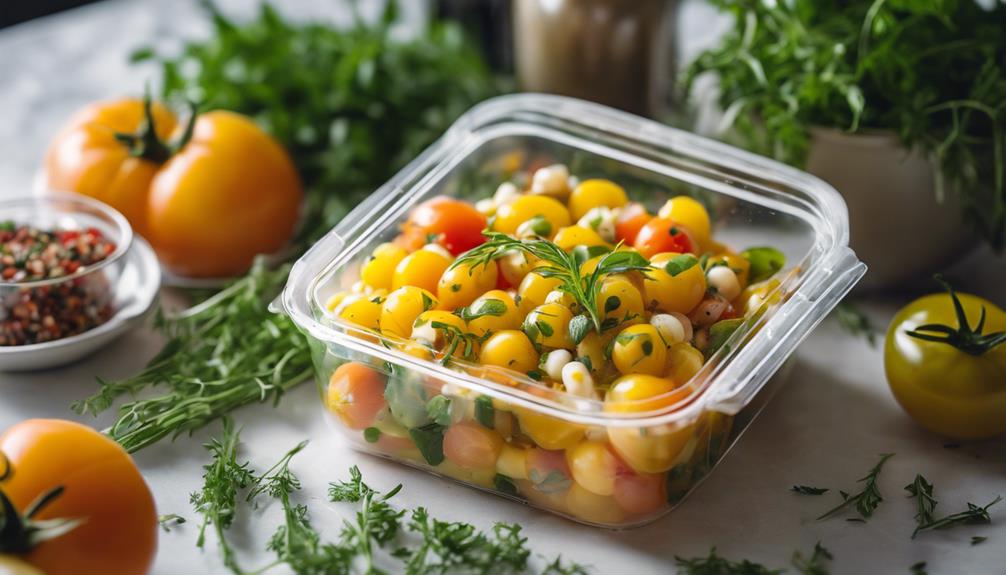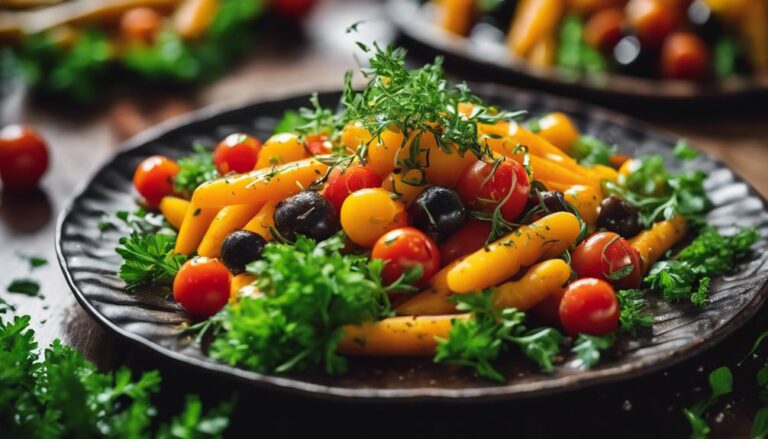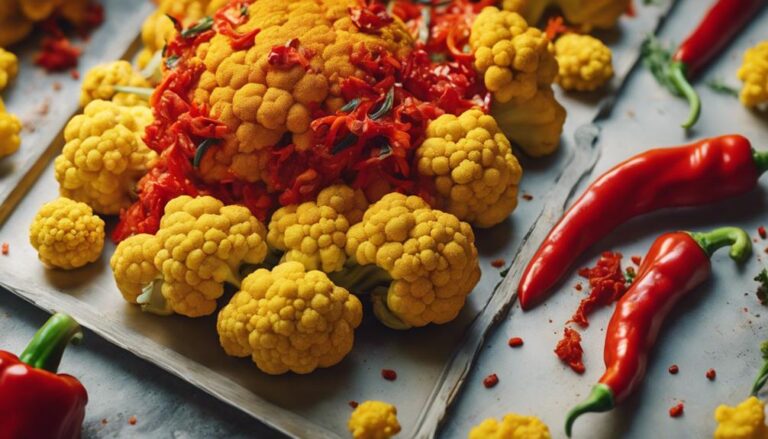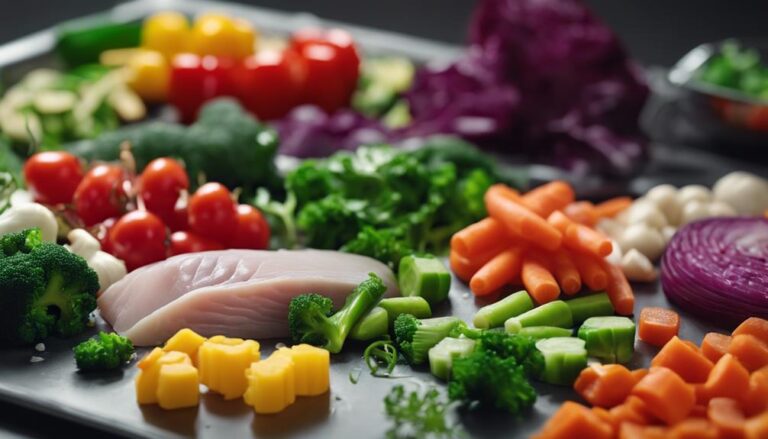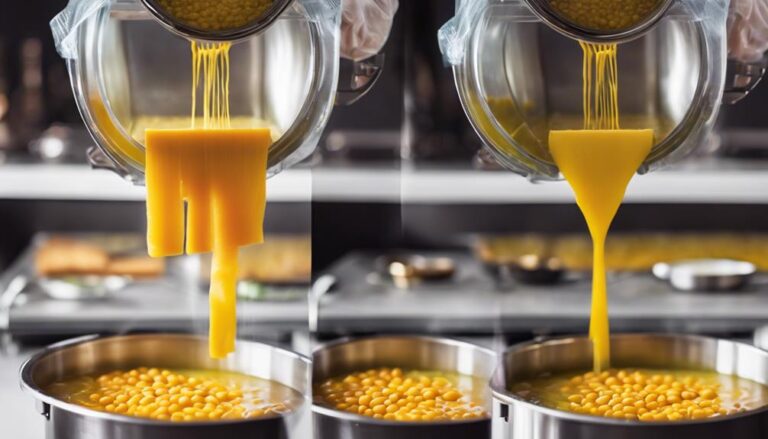Lunch Sous Vide Yellow Tomato and Corn Salad
When it comes to elevating your lunch game, consider exploring the world of sous vide cooking with a delectable Yellow Tomato and Corn Salad. The precise temperature control and vacuum-sealing process involved in this technique create a dish that bursts with fresh flavors and textures. Imagine the juicy sweetness of yellow tomatoes harmonizing with the crispness of corn, all enhanced by a blend of herbs and seasonings. This salad offers a tantalizing culinary experience that will leave your taste buds craving for more.
What You Will Learn Here
- Sous vide cooking enhances flavors in yellow tomato and corn salad.
- Precise temperature control ensures optimal ingredient taste.
- Vacuum sealing retains natural juices for a vibrant salad.
- Experiment with herb-infused oils for added depth of flavor.
- Sous vide method preserves nutrients in vegetables for a healthy lunch option.
Origin of Sous Vide Technique
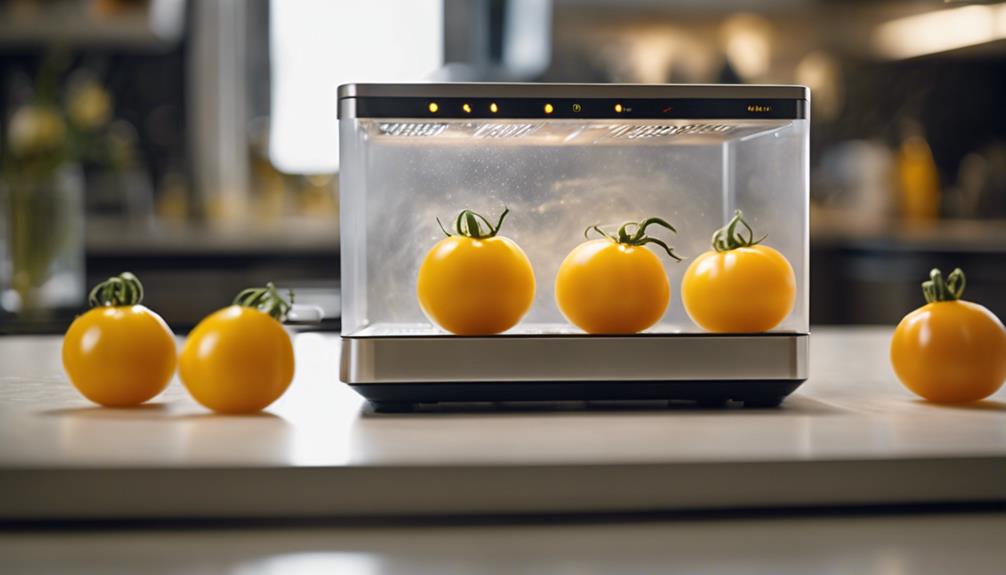
The origin of the sous vide technique dates back to the late 18th century, where it was first utilized as a method to preserve food.
This culinary innovation has evolved over the years, becoming synonymous with precision cooking in professional kitchens worldwide.
Understanding the history of sous vide can provide insight into its transformative impact on modern gastronomy.
Sous Vide History
Ever wondered how the sous vide technique came to be? The history of sous vide dates back to the 18th century when Benjamin Thompson, an American-born British physicist, discovered that food cooked in a vacuum-sealed container retained more flavor and moisture.
However, it wasn't until the late 1960s that Georges Pralus, a French chef, further developed the method for culinary applications.
Sous vide, meaning 'under vacuum' in French, involves cooking food at precise temperatures in vacuum-sealed bags submerged in a water bath. This technique offers numerous benefits, including enhanced flavor retention, improved texture, and consistent results. Chefs can achieve perfect doneness without the risk of overcooking.
To execute sous vide cooking, specialized equipment like immersion circulators and vacuum sealers are used. Immersion circulators regulate the water temperature, ensuring precise cooking, while vacuum sealers remove air from the bags to maintain food quality.
These tools, combined with precise techniques, have made sous vide a popular method in professional kitchens and home cooking alike.
Culinary Innovation
Uncover the roots of culinary innovation with the origin story of the sous vide technique. Culinary techniques have evolved over time, with sustainability trends driving the development of methods like sous vide.
This cooking technique, originating in the 1970s, involves sealing food in airtight bags and cooking it in a water bath at precise temperatures for an extended period. This method not only enhances flavors and textures but also promotes sustainability by reducing food waste and energy consumption.
The sous vide technique revolutionized food preparation by allowing chefs to achieve consistent results and retain the natural juices and nutrients of ingredients. Modern technology has further advanced this method, with the introduction of sous vide precision cookers that guarantee accurate temperature control.
Precision Cooking
Explore how precision cooking transformed culinary practices with the introduction of the sous vide technique in the 1970s. Sous vide, which translates to 'under vacuum' in French, involves cooking food in vacuum-sealed bags at precise temperatures for extended periods. The benefits of sous vide cooking are numerous; it retains the food's moisture, enhances flavors, and guarantees consistent results.
To utilize sous vide cooking techniques, you'll need some essential equipment. A sous vide machine, also known as an immersion circulator, is vital for maintaining the water bath at a constant temperature. Vacuum sealer bags are used to seal the ingredients, preserving their flavors and juices during the cooking process.
Sous vide cooking opens up a world of culinary possibilities with a vast array of recipes available. From perfectly cooked steaks to delicate seafood and even desserts, sous vide techniques offer a precise and foolproof method for achieving restaurant-quality dishes in the comfort of your own kitchen.
Experiment with different ingredients and cooking times to master the art of sous vide cuisine.
Key Salad Components
Salad Variations:
The Sous Vide Yellow Tomato and Corn Salad offers versatility in its composition. You can experiment with different ingredients like adding avocados for creaminess or incorporating arugula for a peppery bite. These variations allow you to personalize the salad to suit your taste preferences and dietary needs.
Dressing Options:
Dressing plays a significant role in enhancing the flavors of the salad. Consider options such as a balsamic vinaigrette for a tangy touch, a honey mustard dressing for a hint of sweetness, or a simple olive oil and lemon juice combination for an invigorating finish. The choice of dressing can elevate the salad's taste profile and bring all the ingredients together harmoniously.
Ingredient Sourcing:
Opt for fresh, seasonal produce when preparing the Sous Vide Yellow Tomato and Corn Salad. By sourcing ingredients like ripe yellow tomatoes and sweet corn during their peak season, you promote that the salad is bursting with flavor and nutrients. Seasonal produce not only enhances the taste but also supports local farmers and promotes sustainability in your culinary endeavors.
Tasty Sous Vide Creations
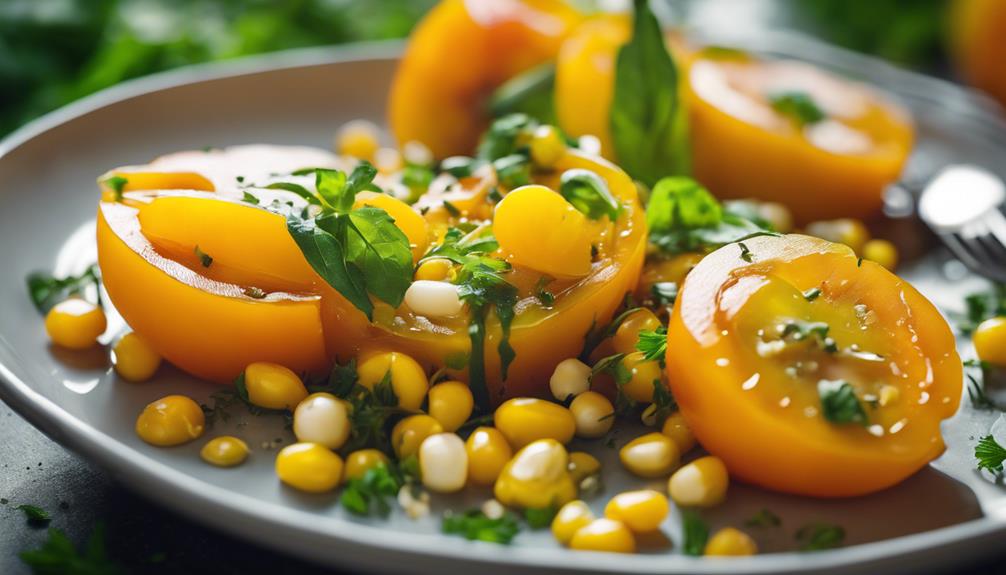
Discover a world of flavorful possibilities with tasty sous vide creations like the Yellow Tomato Salad Recipe, Corn and Basil Salad, and Savory Caramelized Onion Tart.
These dishes showcase the magic of sous vide cooking, infusing ingredients with exceptional taste and texture.
Elevate your culinary skills and impress your guests with these delicious and innovative recipes.
Yellow Tomato Salad Recipe
Curiously, have you ever tried elevating the flavors of yellow tomatoes with a delightful sous vide technique for a vibrant salad creation?
Yellow tomatoes, a delightful variant among tomato varieties, bring a sunny hue and a slightly less acidic taste compared to their red counterparts. When incorporated into summer salads, they add a unique twist to the dish.
To make a scrumptious Yellow Tomato Salad using sous vide techniques, follow these steps:
- Prepare the Ingredients: Gather fresh yellow tomatoes, olive oil, garlic, basil, salt, and pepper.
- Vacuum Seal and Sous Vide: Place the halved yellow tomatoes in a vacuum-sealed bag with olive oil, garlic, salt, and pepper. Cook in a sous vide water bath at a precise temperature to enhance flavors.
- Finish and Serve: Once sous vide cooking is complete, sprinkle fresh basil over the tomatoes, add a touch of olive oil, and season with salt and pepper to taste. Serve the vibrant Yellow Tomato Salad as an invigorating side dish or a light meal on its own.
Corn and Basil Salad
Elevate the flavors of your corn and basil salad with a tantalizing sous vide twist.
Flavorful Combinations:
Sous vide cooking allows the corn to retain its natural sweetness, enhancing the flavor profile of the salad. When combined with the aromatic basil, the result is a burst of fresh and vibrant tastes in every bite.
Seasonal Ingredients:
Utilize the best of the season by incorporating fresh corn and basil into your salad. Seasonal produce not only tastes better but also supports local farmers and guarantees peak freshness in your dish.
Culinary Creativity:
Experiment with sous vide techniques to infuse the corn and basil with unique flavors. This method opens up new possibilities for your salad, showcasing your culinary skills and creativity with fresh produce.
Savory Caramelized Onion Tart
Enhance your culinary repertoire with a delectable savory caramelized onion tart, crafted using innovative sous vide techniques.
- Immerse yourself in a world of flavor with caramelized onion variations, from sweet to tangy, adding depth to your tart.
- Explore savory pastry options like flaky puff pastry or buttery shortcrust, elevating the texture of your tart.
- Experiment with different herbs and cheeses to complement the rich caramelized onions, creating a truly personalized culinary delight.
Caramelized onions are an important ingredient, offering a range of taste profiles depending on how long they're cooked. Whether you prefer a sweeter caramelization or a more intense, savory flavor, adjusting the cooking time can achieve your desired taste.
Pairing these onions with the right pastry is essential; a buttery shortcrust can provide a sturdy base, while a flaky puff pastry adds a light, airy texture.
Don't be hesitant to mix in herbs like thyme or rosemary, along with cheeses such as goat cheese or gruyere, to enhance the overall taste experience of your savory caramelized onion tart.
Sous Vide Temperature Control
When using sous vide cooking, precise temperature settings are essential for achieving consistent cooking results. Maintaining a steady temperature throughout the cooking process guarantees that your food cooks evenly and retains its moisture and flavor.
Additionally, the energy efficiency benefits of sous vide cooking make it a convenient and eco-friendly cooking method.
Precise Temperature Settings
To ensure optimal results in sous vide cooking, you must carefully set and monitor the precise temperature settings for your ingredients. Sous vide equipment, such as immersion circulators or water ovens, allows you to control the cooking temperature with incredible accuracy, ensuring that your food cooks evenly and retains its flavors and nutrients.
One of the key sous vide benefits is the ability to cook ingredients to the exact doneness you desire by maintaining a constant temperature throughout the cooking process.
When setting the temperature for your sous vide cooking, it's essential to follow the recommended temperatures for different types of food. For example, delicate proteins like fish might require lower temperatures around 120-130°F, while tougher cuts of meat could benefit from higher temperatures ranging from 130-160°F.
Monitoring the precise temperature settings throughout the cooking time will help you achieve consistent and delicious results every time. By paying attention to these details, you can harness the full potential of sous vide cooking and create restaurant-quality dishes in the comfort of your own kitchen.
Consistent Cooking Results
Maintaining precise temperature control in sous vide cooking is crucial for achieving consistent and reliable cooking results. By mastering the cooking techniques and temperature control in sous vide, you guarantee that your dishes come out perfectly each time.
The water bath's steady temperature ensures that your food is cooked evenly, eliminating the risk of overcooking or undercooking. This precise control leads to consistent results, making it easier to replicate your favorite dishes with the same level of quality every time.
Furthermore, the controlled temperature in sous vide cooking allows for ideal flavor infusion. The vacuum-sealed bags lock in the natural juices and flavors of the ingredients, resulting in a more intense and delicious taste.
Whether you're cooking meats, vegetables, or desserts, the consistent temperature control ensures that the flavors are evenly distributed throughout the dish, creating a harmonious and delectable final product. Mastering the art of temperature control in sous vide cooking not only guarantees consistent results but also enhances the overall flavor profile of your dishes.
Energy Efficiency Benefits
Achieving energy efficiency through precise temperature control in sous vide cooking optimizes resource utilization and minimizes wastage. By maintaining a constant temperature throughout the cooking process, sous vide cooking guarantees that only the necessary amount of energy is used, leading to cost savings and reduced environmental impact.
This sustainable cooking method not only helps in saving energy but also contributes to reducing overall waste.
The precise temperature control of the sous vide technique allows for minimal heat loss, unlike traditional cooking methods where heat is constantly adjusted to maintain the desired temperature. This efficient use of energy translates into lower electricity bills and a smaller carbon footprint, making sous vide cooking an eco-friendly choice for the environmentally conscious cook.
Final Thoughts
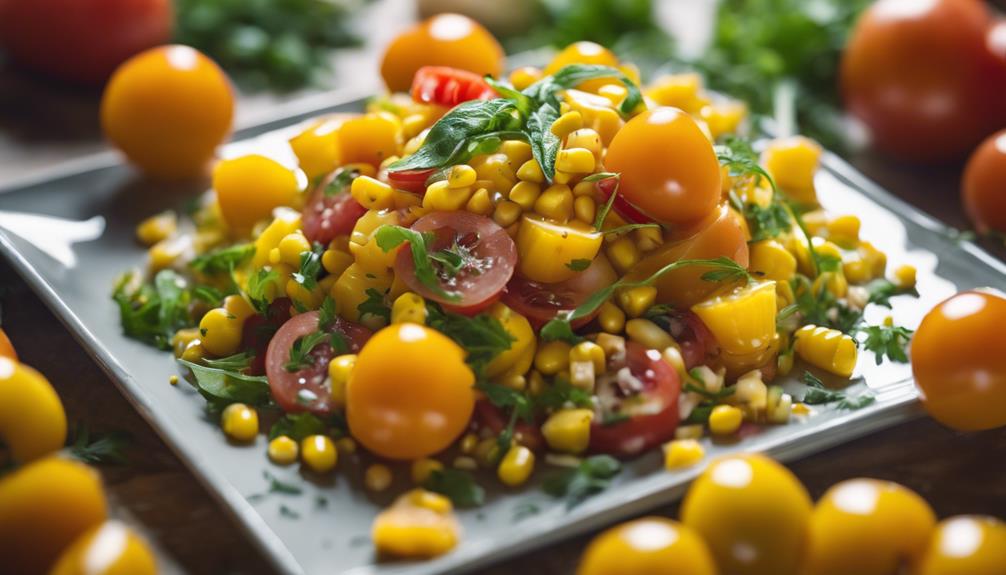
For an invigorating and vibrant dish that celebrates the flavors of summer, consider serving this Sous Vide Yellow Tomato and Corn Salad as a delightful addition to your menu. The benefits of sous vide cooking are evident in this dish, with the precise temperature control enhancing the flavors of the yellow tomatoes and sweet corn, resulting in a burst of fresh taste in every bite.
When it comes to creative salad variations, this recipe offers a unique twist by incorporating seasonal ingredients that are at their peak in the summer months. The combination of juicy yellow tomatoes, sweet corn, and a zesty dressing creates a harmonious blend of flavors that will surely impress your guests.
Frequently Asked Questions
Can I Use a Regular Pot Instead of a Sous Vide Machine?
You can use a regular pot instead of a sous vide machine for cooking. When comparing stovetop vs sous vide, remember alternative cooking methods to achieve similar results. Sous vide provides precise temperature control, while stovetop offers versatility.
How Long Can I Store Sous Vide Salads in the Fridge?
You can store sous vide salads in the fridge for up to 3-4 days. To guarantee freshness, properly store them in airtight containers. Check for any signs of spoilage before consuming. This will make sure you enjoy your salad safely.
Is It Safe to Cook Sous Vide Without Vacuum Sealing?
Yes, it's safe to cook sous vide without vacuum sealing, but be cautious. Food safety is essential. Alternative methods like zip-top bags work, but vacuum sealers aid in better flavor retention. Follow proper guidelines.
Can I Reuse the Sous Vide Marinade for Other Dishes?
You can reuse the sous vide marinade for other dishes. It's versatile and can enhance various meals. Get creative with combinations like using it to marinate meats or vegetables for added flavor.
Can I Add Dairy Products to Sous Vide Salads?
You can add dairy to sous vide salads, but be cautious. Verify that dairy is fresh and pasteurized. Keep sous vide temperatures safe to prevent bacteria growth. Experiment with small batches first to find the right balance.
Conclusion
To sum up, the Sous Vide Yellow Tomato and Corn Salad is a delightful and nutritious lunch option that's easy to prepare using the sous vide technique.
By cooking the ingredients at a precise temperature, you can elevate the flavors and textures of the salad, creating a vibrant and invigorating dish.
Experiment with different seasonings and herbs to customize this salad to your taste preferences, making it a versatile and flavorful meal choice.
Enjoy the benefits of sous vide cooking with this delicious salad!
